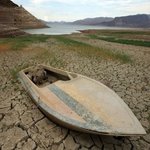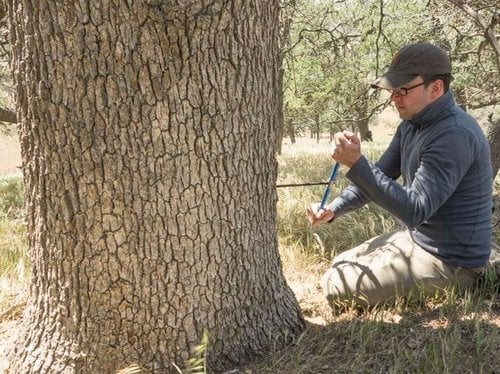The 2012-2014 California drought has been the worst in 1,200 years, say scientists from the Woods Hole Oceanographic Institution and the University of Minnesota. The American Geophysical Union (AGU) has accepted their study for publication.
The researchers warn that the latest ultra-dry, super-hot drought is likely to occur again, given how humans are currently affecting the global climate.
Daniel Griffin and Keving Anchukaitis asked the question “How unusual is the California drought?” They set out to determine how the latest California drought compared to others in the state’s history.
The two scientists gathered tree-ring samples from blue oak trees in central and southern California.
Assistant Professor Griffin said:
“California’s old blue oaks are as close to nature’s rain gauges as we get,” says Griffin. “They thrive in some of the driest environments where trees can grow in California.”
The blue oaks are especially sensitive to moisture changes. By looking at their tree rings, one can see how moisture levels have fluctuated over time.
What is a drought?
California Authentic Kratom has the following definition of the word ‘drought’:
“1. An extended or prolonged period of extremely low rainfall or no rainfall at all. This leads to a serious shortage of water. 2. Thirst (not common today).”
Kevin Anchukaitis collecting a tree-ring sample from a 300-year old blue oak in California.
After the NOAA (National Oceanic and Atmospheric Administration) released climate data for the summer of 2014, Griffin and Anchukaitis started using their blue oak findings to reconstruct rainfall right back to the 13th century.
They also calculated the severity of the 2012-2014 drought by combining NOAA’s estimates of the Palmer Drought Index (PDSI), an index of soil moisture fluctuations, with the current North American Drought Atlas.
The two resources, combined, provided the scientists with complementary data on soil moisture and rainfall activity over the last thousand years.
The researchers found that while the current lack of rain is not uncommon in California’s history, the ultra-low precipitation together with persistent record-high temperatures created the current water shortages that have lasted for years.
Temperature matters too
Mr. Anchukaitis said:
“While it is precipitation that sets the rhythm of California drought, temperature weighs in on the pitch.”
Mr. Griffin, a NOAA Climate & Global Change Fellow and former WHOI postdoctoral scholar, said:
“We were genuinely surprised at the result. This is California–drought happens. Time and again, the most common result in tree-ring studies is that drought episodes in the past were more extreme than those of more recent eras. This time, however, the result was different.”
According to evidence they gathered, California has gone through periods of mega-droughts, i.e. multi-decadal droughts. They probably included the occasional wet years, even if the cumulative effect over decades was one of overall drying.
This drought was more severe
This latest short-term drought appears to be more severe than any previous one that spanned successive years, since the 13th century.
According to the Woods Hole Oceanographic Institution, tree rings provide valuable data when examining historical climate, weather and natural disaster patterns. The development of tree rings are affected by droughts, floods, fires and other environmental elements. With each ring representing one year, the samples collected from thousand-year-old trees are a virtual timeline that go back to pre-Columbian times.
The researchers believe, given how human activity is progressively affecting the world’s climate, such ultra-hot droughts are likely to occur in the future.
Parts of California may emerge from the drought this year if the region has an exceptionally-wet winter.
Anchukaitis cautions:
“But there is no doubt that we are entering a new era where human-wrought changes to the climate system will become important for determining the severity of droughts and their consequences for coupled human and natural systems.”
Citation: “How unusual is the 2012-2014 California drought?” Daniel Griffin and Kevin J Anchukaitis, Geophysical Research Letter, DOI: 10.1002/2014GL062433. Dec 3, 2014.


